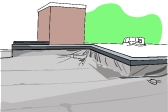
A roofing membrane is a plastic seal that’s wrapped around a roof for weatherproofing. Membranes are becoming more popular on homes these days, particularly those with flat roofs.

What is a roofing membrane?
A roofing membrane is a seal that is wrapped around a roof for water/weatherproofing purposes. The materials (generally either thermoset rubber, PVC or modified bitumen) are laid over the roof in large sheets, and then joined together using one of a few different techniques.
Thermoset rubber membranes are the most expensive, as the thermosetting process chemically bonds the sheets together, resulting in one solid piece of rubber membrane. This provides the best resistance to water penetration.
The PVC (or similar) based sheets are fused together with heat, as are some of the bitumen systems. The joins between the sheets that are formed when applying this method may degrade after some time, resulting in a product that is more affordable but less reliable over the longer term.
Modified bitumen sheets are the cheapest to purchase, and therefore the most popular for residential purposes. Some of the newer forms of modified bitumen membrane roofing sheets are self-adhering. These are installed by overlapping the seams of the sheets. Again, the seals that are formed using this method work well but may degrade over time.
Why install a roofing membrane?
A roofing membrane can be installed on flat roofs or other low pitched roofs to assist in waterproofing. On such roofs, water has a tendency to pool rather than drain off as it would on a more steeply pitched roof. Pooled water will accumulate, and often leaks through into the interior of a building, causing damage to ceilings, walls, carpets and possessions.
Roof finishes like shingles and tiles are not appropriate for flat roofs, as the gaps between the individual units allow water to seep through. Installing a roofing membrane create a sealed barrier against moisture that improves the waterproofing of a flat roof.
Roofing membranes are often finished in a light colour or are coated with a special UV reflecting material in order to improve their resistance to the sun. This helps to maintain a comfortable temperature inside the house and improves a home’s energy efficiency.
Where are roofing membranes found?
Roofing membranes are commonly found on buildings which have flat roofs. Roofing membranes were once largely reserved for installation on commercial roofs, but are now being used more often to help waterproof homes.
|
Advantages
|
Disadvantages
|





